“The Other World War 2”: Wargaming in the Pacific (Part Two)
August 11, 2014 by crew
In the first part of this article series, we took a look at a few highlights of wargaming in the Pacific theatre of World War II, specifically the China-Burma-India (CBI) campaign and the South Pacific campaign. In this segment, the Central Pacific is reviewed through the wargamer’s eye, as well as the purely naval aspect of the Pacific War.
As discussed in the previous article, the South Pacific was an Army-dominated campaign fought over the large landmasses of New Guinea, the Solomon Islands, and the Bismarck Archipelago. The campaign’s commander, General Douglas MacArthur, was given a significant naval force to support numerous amphibious operations, but the islands were large and relatively close together. Predominantly this was a ground-based jungle campaign fought by Americans, Australians, and New Zealanders against the Japanese, with a heavy emphasis on land-based airpower provided by bases on nearby islands.
In the Central Pacific, the islands are tiny and separated by thousands of miles of water. Here, the US Navy held sway under the inspired leadership of Admiral Chester Nimitz. Most of the ground fighting was carried out by US Marines, and almost all the airpower was carrier-based Navy and Marine squadrons.
Central Pacific gaming probably presents the biggest the “Pacific challenge” to wargamers accustomed to European rules systems and scenarios. After all, many CBI and South Pacific games can be built rather conventionally, set up on battlefields thick with “woods” (i.e., jungles), mountains, streams, and swamps. Central Pacific battles, however, really are a different animal and require substantial investment on the part of potential gamers.
Tactically, the first thing one notices is the tiny size of the battlefields and the incredible manpower densities deployed into them. Whereas New Guinea is three times the size of Great Britain, Betio Island (part of the Tarawa Atoll in the Gilbert Islands) is just three kilometres long and 350 meters across where the Marines landed. Yet this island was fought over by about 20,000 men. For the invasion of Iwo Jima, 70,000 Marines fought with 21,000 Japanese on an island three miles long, making this tiny island the most densely-populated spot on Earth for the five weeks that fighting raged there.
This density makes the Central Pacific relatively unfertile ground for many wargamers expecting a European-style tactical battle. There is no room to manoeuvre, no flanks to turn. Instead, staggering volumes of American firepower and numbers are pitted against fanatical Japanese dug into impervious positions, presenting a classic case of “unstoppable force against immovable object.” Another challenge is the map. Because these islands were so small, it’s tough to build a generic “Pacific beach” miniature table in scales like 15mm or 10mm, at least one that you could use more than once. Since many European-war gamers are interested in the Pacific only as an occasional change of pace, the work required to build dedicated Pacific tables sometimes seems like too much. Even hex boards present a problem because even moderately-sized island maps will require hundreds of counters representing tens of thousands of men. On the other land, taking just a slice of a given island reduces the number of counters needed, but now the map would encompass only a few dozen hexes.
The way to get around this is to change your scale of wargaming. One option is to go for very “small” games like Bolt Action, Valour and Victory, or Lock and Load. With a board or table representing a depth of only 100 meters or so, American players can take a company of Marines out of the surf, across the sand, and into some of the prepared Japanese bunkers and caves. Just remember to give the Japanese very formidable fortifications, and require the Marines to make difficult rolls in spotting them. The Americans should have at least a 2-1 edge in numbers, as well as special rules for huge volumes of firepower coming from off the board. It’s doubtful that the Marine sergeants, lieutenants, or captains would have direct communication with the cruisers and battleships shelling these beaches or the bombers dropping napalm and frag, so their targeting should be somewhat “random” and not entirely at the discretion of the American player.
Victory conditions are another important factor. Japanese garrisons always lost once the Americans landed, and always took nearly 100% casualties. So victory conditions should be based on how long they last. The Americans will “always” win, but were leery of taking too long or suffering too many casualties.
Another option is to scale up to operational-level gaming. As discussed in The Four Levels of Wargaming article series, this is where players command thousands of men over days, weeks, or months. By adopting this model, players circumnavigate the brutal Pacific “shoving match” by expanding the game to include the whole island, all its surrounding islands (most of these were atolls and archipelagos, remember), and of course all the surrounding ocean. Which beaches will you land on, and as the Japanese player, which will you fortify most heavily? Airpower has to be coordinated off the American carriers, and if you want anything bigger than a Dauntless dive-bomber, you’d better take some surrounding islands and bring in engineers to build airstrips for larger ground-based bombers. Speaking of land based bombers, do the Japanese have any bases on neighbouring islands, and if they do, how much will the Americans allocate to their seizure? More landings mean more support craft, and more vulnerability for prowling Japanese submarines unless you’ve set up a proper ASW (antisubmarine warfare) screen with your destroyers and Catalina flying boats.
The Japanese Navy has to be considered, not only surface warships (Guadalcanal’s “Tokyo Express” is a great example) but counterattacking carriers as we see in the battles like Santa Cruz and the Philippine Sea. Japanese battleships suddenly appearing amidst a vulnerable American invasion fleet is a nightmare that almost came true at the Battle of Leyte Gulf (largest sea battle in human history). But of course the more naval assets you commit to security of your sea lanes and invasion beaches, the less you have available for shore bombardment and ground support air strikes.
Then there’s the topography of these islands to consider. Since most of these islands were part of coral atolls, careful reconnaissance has to be done to see just where these deadly reefs are and which approaches to the target island are really open. Yes, even in the open ocean there is “terrain.” The Americans failed to account for this at Tarawa, resulting in near-disaster when their assault boats bottomed out on the reef and Marines had to struggle ashore through a thousand yards of neck-deep water. So bad was the disaster that the Navy founded Underwater Demolition Teams to map and clear gaps in these reefs before the invasion. These elite units eventually evolved into the Navy Frogmen, and finally the Sea Air and Land teams, more famously known as the Navy SEALs . . . all because of the coral reefs of Tarawa.
Sadly, there are few purely tactical naval games in the Pacific (Clash at Arms’ “Command at Sea” is one notable exception). This may be because most of the major naval battles were fought between carriers, and with the great distances involved these games become operational-scale anyway. Avalon Hill’s Midway is a great entry-level game, although it’s a little simplistic. On the other end of the spectrum is the classic Flat Top, a complex study of the four pivotal carrier battles around the Solomon Islands in 1942 and early 1943. One more option is Decision Games’ South Seas Campaign: 1942-43 (designed by Joseph Miranda), a full air-land-sea study which allows everything from commandos to a potential Japanese invasion of Australia.
In summary, the Pacific War offers a vast new arena for the wargamer to explore. It was very different from the war in Europe, so gamers who bring European rules and expectations to the Pacific do so at their peril. But for those willing to try something new, the Pacific offers depth and scope sure to provide years of great gaming.
If you would like to write an article for Beasts of War then please contact me at [email protected] for more information!
"...their targeting should be somewhat “random” and not entirely at the discretion of the American player"
Supported by (Turn Off)
Supported by (Turn Off)
"...the Pacific offers depth and scope sure to provide years of great gaming."
Supported by (Turn Off)









































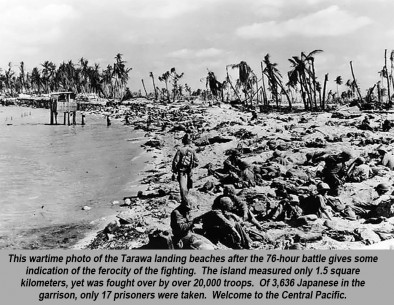
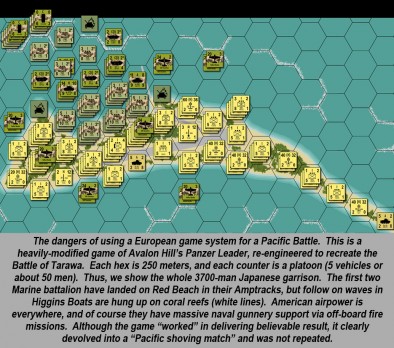
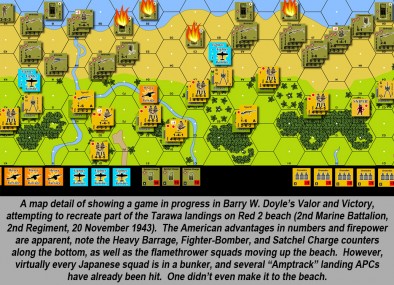
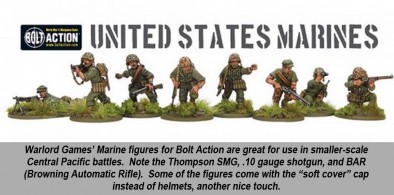
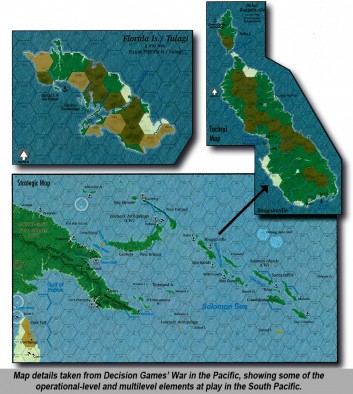
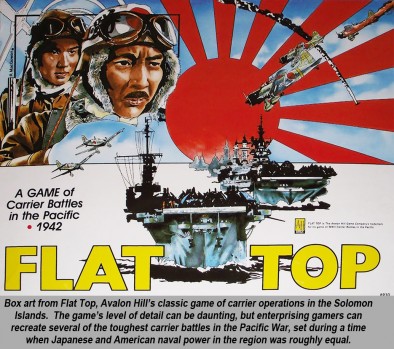


































Ok, this may be too intense a gaming style for poor brain, but it looks/sounds impressive. How did u keep that Tarawa battle straight? I definitely this seems like a time for alternate levels or combined level games.
Another great one, Thanks! Though I am a little disappointed u didn’t mention Halsey so I could whip out my Red October, Sean Connery quote 😉
“I KNOW this book. [chuckle] Your conclusions were all wrong, Ryan. Halsey acted stupidly.”
>>> Beg to differ, Mr. Sean Connery. 🙂 Yes, we all know he’s talking about Leyte Gulf there, but Halsey’s actions can hardy be called “stupid” given the information in hand. But I make it a rule not to get into historical arguments with fictional characters.
Thanks for the feedback!
I think the hardest part of taking islands was that the Japan’s troops like the Vietcong made it so difficult to advance because of all the tunnel works making it impossable to predict counterattacks slowing down & stopping troops advancing quickly relatively safely.
Thanks, @zorg . Indeed, a lot of the Japanese islands had extensive tunnel complexes (Peleliu, Iwo Jima, Okinawa are examples). Valor and Victory (print and play, still free last I checked) has great, simple rules for Japanese in tunnels (small, fun, quick, and actually pretty faithful squad-level game, at least when it comes to infantry).
You could use a simple rule like if a square/hex is empty for one turn the enemy player can attack from that space for any Map for example.
I don’t have the rules in front of me, @zorg , but the game includes counters for “Caves,” which the Japanese player deploys at the start along with foxholes, bunkers, mines, etc. If the scenario calls for it, the Japanese player can “teleport” units from any cave hex to another cave hex within four hexes (hence, underground movement). This way the Japanese player can also use the tunnels as craters / fighting positions from which to shoot, as well as an emergency transport system. A friend and I played 10 scenarios or so “marching” up the Pacific, and I always… Read more »
that’s the kind of thing anyone could make tunnel cards for. for any game they are playing just to mix it up a bit @oriskany
Cards are a good idea, @zorg . Valor and Victory doesn’t come with them, and to be honest I used to swear against them. But a friend of mine at our local gaming club is getting me into Tide of Iron, which uses “Strategy” and “Event” cards . . . and I’m starting to become a fan.
Anything that helps change/vary games & takes some of the predictability out of games.
I would agree that games should not be boring ot repetitious. Maybe they should be a little predictable, though? At least in the sense that the better player should usually win, good planning and solid execution should *usually* win out over wild swings of fortune? This is the reason I *used* to veer away from wargames that included cards. The one I’ve tried, though (Tide of Iron) allows players to choose when and how a card is “spent,” making it one more part of a “predictable” strategy.
Thanks for the historical notes (like the SEALS one)! I was wondering if I could get information on the Korean War (the Forgotten War). I’ve heard some interesting things on it and I’d like to get more information so I’d thought I’d see if you had some literary resources that you’d recommend?
There are a couple of good Korean films on the Korean War, the names escape me at the miniute but I remember them being good
M*A*S*H (the original Donald Sutherland movie, not the TV series) is the only one I know off the top of my head. I vaguely remember a little of Pork Chop Hill (Gregory Peck), but I think I was like 8 when I saw part of it. 🙂
I found a list of movies, linked below. I’ve seen bits and pieces of a modern South Korean movie about the Korean War. It looked quite good, but I don’t know which one of these it was.
http://en.wikipedia.org/wiki/List_of_films_about_the_Korean_War
Brotherhood of war is one of the films I was thinking of
Hmm . . . the Korean War indeed doesn’t get nearly the attention it deserves. The only book I’ve read on the subject recently is “Breakout: The Chosin Reservoir,” linked below: http://www.amazon.com/Breakout-Chosin-Reservoir-Campaign-Korea/dp/0140292594 The battle has a legendary status in the US Marine Corps. Anyway, some of the BoW community was talking about Korean War gaming recently when Flames of War came out with their M26 Pershing. Sure, everyone wants to use it for “late war” WW2, but the window to use them there is so narrow (only a handful arrived in Germany in time to actually see combat). In Korea,… Read more »
Oops, above comment about Korean War books was supposed to be in response to @leoleez . 🙂
I think Avalon Hill’s Squad Leader would be a good board game to play the Pacific campaign. I enjoyed it in its original configuration, was less enthralled with Cross of Iron, and became lost somewhere in the middle of Crescendo of Doom. I bought GI: Anvil of victory, but couldn’t absorb enough rules to play the game lol. Steel Panthers World at War (SPWAW), a top down turn based computer game, does a good job of recreating the Pacific battles, and has a good engine for designing your own scenarios. It is a squad/support weapon/individual vehicle level game. And of… Read more »
Augh! Advanced Squad Leader! A great game, don’t get me wrong, but MAN what a stack of rules. I still have some of the boards, and I remember playing the Stalingrad scenarios in the barracks (waaaaaay back in those days, 23 years ago +), complete with a little spool of black thread to help resolve tricky LOS questions. ASL did come out with a few modules for the Pacific. Specifically, Code of Bushido for the Japanese, then Gung-Ho for the USMC and Chinese. Of course, we tried some of the Gung Ho stuff in the dimly-remembered days of my USMC… Read more »
I’m a fan of the idea of Pershings vs T3485s and SU100s.
But, great article Oriskany. That 1st map of Tarawa looks awesome. Ah, I don’t nostagically harken back for the days of dry erase markers, plastic sheets and blank hexes. Great stuff!
Hey, that map of Tarawa is basically a cleaned-up version of that old dry-erase map sheet where you and I first tested the Panzer Leader system at Tarawa. Our map had a **little** more room since we used 150-meter “house rules” hexes instead of official 250 meter hexes, but I’m trying to illustrate the point that using European wargame systems at the wrong scale can produce, well, games like this. The whole island of Tarawa covers just 33 hexes, while even an average Panzer Leader game in France or Belgium covers 600+ hexes (2 map boards) for the same general… Read more »
Loving this series. Keep up the great work.
Thanks, @ghostbear . 🙂
Nice work there again mate. I didn’t know about the SEALs factoid – it makes sense though. Living next to the Great Barrier Reef I can totally see how a reef would require clearance if it was in front of where you wanted to land. Often they are hard to find until you are on them, unless you have got them previously mapped. That is why Cooktown is named after Captain Cook- it is near where he “found” a similar reef by mistake. It ruined his day too. ;p
Thanks, @wookiehair . For the Marines at Tarawa, the ideal solution was the Amptrack, a truly amphibious APC (unlike conversions like the DD Shermans of Normandy fame). The problem was, they didn’t have enough of these for all the Marines. So the general doctrine was to send the first wave in with Amptracks, then successive waves in conventional Higgins Boats. Well, the Amptracks negotiated those reefs easily enough, and the first wave engaged the Japanese on those tiny, murderous little beaches. But the 2nd, 3rd, and successive waves couldn’t get to them when they hit the reefs. So not only… Read more »
I saw the flaws that you have mentioned in this part of the article and I must agree that BOLT Action can be a really good alternative to larger scale games where you would have to move dozens of counters on a relatively small area. I think the so called “grand campaign” games can also be an answer for people who have a lot of time and meet on a regular basis. btw. I love the article.
Thanks, @yavasa . I just hope that Bolt Action fans don’t think I’m downplaying the game or saying that it only works in a Pacific setting. I know they have a new book coming out focused on tanks, and Bolt Action / Warlord tank miniatures indeed look fantastic. But the idea of running tank vs. tank battles in 28mm “true line of sight” on anything smaller than a tennis court seems problematic (and I’m far from the only BoW community member who’s expressed this concern). However, these very same characteristics are what probably makes Bolt Action one of the best… Read more »
Sorry @oriskany I read my post again and I believe that the structure of my sentence suggests something else than intended. I have assumed that BOLT Action can be a nice alternative for games (small scale like one landing) where you would have to put a really significant number of counters in order to play like in the shot of the modified Panzer Leader. Now, the second part of my previous post was supposed to concern “grand campaign” games but I think that it blurred with the previous part about the counters. I can see your point thou. Actually big… Read more »
I agree, @yavasa , that operational games or strategic game can be very time consuming, even if they aren’t terribly complicated, simply because they are long. Also, it can be a bit of a paradigm shift for gamers accustomed to tactical games, which might als contribute to a longer learning curve. I mean, if you know a couple of tactical games, learning one more isn’t usually that hard since the concepts are all similar. Here, the actual “reality” the game is trying to replicate might be very different.
*****
“I can see your point thou. Actually big scale games usually have simpler rules then small scale ones. Take Squad Leader for example. Numerous detailed rules concerning well everything actually.”
*****
Agreed. What can be more (or made more) complex than an RPG with a player playing one or maybe two people. Where you track rounds fired from a rifle instead of supplies and cargo in tonnages and such.
Very true about the complexity of extremely small-scale wargames, @amphibiousmonster , all the way down to military-themed RPGs. Individual wounds, fatigue, rounds per weapon, rates of fire, I’ve even tried one game (Phoenix Command) that tracked time of flight for bullets in 1/10 of a second impulses. A touch much, to be honest. 🙂 All I would add is that while very small games like this can be very complex, they’re also pretty intuitive since the “scope of experience” is pretty similar to what people experience all the time. No, they’re not in combat (hopefully), but we’ve all been “one… Read more »